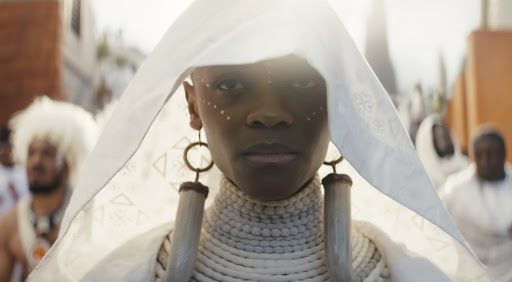A “Black Panther 2” seemed out of the question when Chadwick Boseman unexpectedly died of colon cancer in August 2020. Boseman was more than just the center of the first film as King T’Challa, ruler of the fictional African nation of Wakanda. He symbolized the progression of Black actors and films, proving Black superheroes could walk among the many others with numerous movies of their own.

How was director and screenwriter Ryan Coogler going to fill that huge hole Boseman left in the franchise?
Coogler decided he wouldn’t try to. He — and co-screenwriter Joe Robert Cole — delicately paid homage to Boseman in the beginning, end and post-credit scenes of “Black Panther: Wakanda Forever,” but his loss is purposely felt throughout as the Wakandans try to find a way to restore order and defend their vulnerable nation without their leader. Coogler explained in “The Official Black Panther Podcast” that replacing Boseman wouldn’t have felt truthful; the truth was “loss, the fact of life, the gift and the curse of life: heroes, great men, die.”
We see that truth as the film opens with a frantic Shuri (Letitia Wright) in her futuristic lab searching for a cure for her brother’s undisclosed illness before she finds out it’s too late. An emotional funeral follows before it turns into a celebration of T’Challa’s life, allowing for beautiful, angelic shots of everyone dressed in all white (another stunning choice from returning, Oscar-winning costume designer Ruth E. Carter). The prologue ends with scenes of Boseman from the first film filling the Marvel logo in silence.
A year later, foreign nations have remained relentless in their quest for vibranium, the precious metal that only Wakanda, now led by Queen Ramonda (Angela Bassett), was known to possess. However, a CIA expedition in the Atlantic Ocean reveals vibranium is also found in Talokan, an underwater empire. Its leader Namor (Tenoch Huerta, who nailed this breakthrough role) strikes a deal to team up with Wakanda against the surface world, but when Shuri declines, it creates a war on its own.
The bright spots in the film come from the spectacular acting, specifically within the strong Black female cast. Viewers are consumed in Shuri’s grief, and Wright shows what it is like to be forced to make difficult decisions when you haven’t even allowed yourself to truly feel all your emotions.
Bassett was destined to portray Queen Ramonda; her regalness and eloquence is undeniable and captivating. The face of the French representative in a U.N. meeting after Ramonda’s speech says it all. Nakia (Lupita Nyong’o) brings a calming presence that levels out the fast-paced, action-packed scenes; her untroubled determination saves the day multiple times. Okoye’s (Danai Gurira) intensity and dedication to her role in the Dora Milaje is almost tangible, but still, her comedic one-liners land perfectly every time. Even RiRi (Dominique Thorne), the 19-year-old MIT prodigy, commands the camera with her sass and intelligence; yet, her naivete and innocence still comes through.
Talokan and its band of blue, aquatic inhabitants (think “Avatar” meets “The Little Mermaid”) adds excitement to the sequel. They create a visually appealing element unlike anything I have seen in Marvel films. Namor, with winged ankles and pointy ears, reveals his backstory full of loss and anger, making him the perfect anti-hero, replicating Killmonger from the first film. We see a few glimpses of Talokan, a sort of Mayan Atlantis, pearlescent and glistening even at the depths of the ocean. Hannah Beachler — set designer and another Oscar-winner from the original movie — creates a majestic underwater fantasyland that needed just a few more minutes of screen time.
Perhaps I will have to wait until “Black Panther 3” to see more, because this one could not fit anything else. The 160-minute film was bursting with so many characters and their underdeveloped plot lines, while extending a little too long on other scenes. Some true Marvel fans might know, but it would’ve been helpful to expand on RiRi, who apparently played a role in the “Iron Man” storylines, which took place before the time period of “Wakanda Forever.” CIA agent Everett Ross (Martin Freeman) and his boss/ex-wife Valentina Allegra de Fontaine (Julia Louis Dreyfus) have an interesting and comedic relationship, but they don’t get enough scenes to get the full potential out of it. And as talented as Huerta is, Namor is a bit wordy and his conversations last a beat too long.
The film is still a Marvel movie: car chases ending in explosions, heavy combat-driven fight scenes, an imminent danger that feels almost insurmountable to the protagonists and their army. But Coogler created bookends with the opening and closing scenes that bring the film back to the themes of loss and reflection (and foreshadowing, as seen in the mid-credit scene) surrounding Boseman. While the actor is not physically in the film, his presence and the love and appreciation of both the cast and the characters is felt.
De Turner is a fourth-year journalism major and sport management minor.









Show Comments (0)